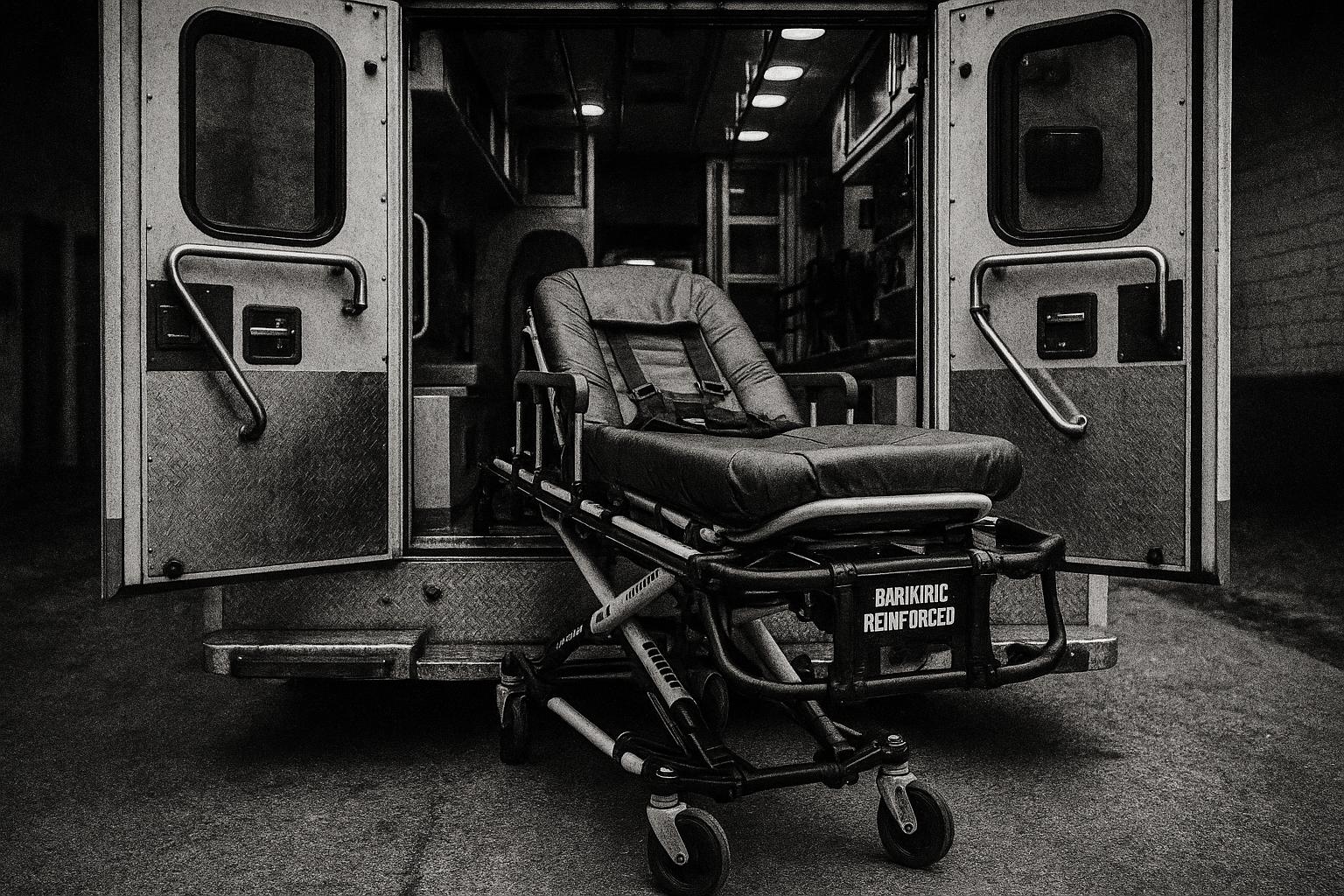Ambulance trusts across England have spent roughly £27.5m on specialist bariatric transport in recent years, either buying reinforced vehicles and lifting kit or paying private contractors. North West Ambulance Service has paid nearly £15m and says it will purchase bespoke vehicles to curb private‑hire bills as rising obesity and hospital handover delays strain response times.
Ambulance trusts across England have spent tens of millions of pounds in recent years to ensure very obese patients can be transported safely, a patchwork of Freedom of Information disclosures and official figures shows — a drain on resources that is occurring against a backdrop of rising demand and tightening response-time targets.
According to the original report, trusts have incurred roughly £27.5 million in extra costs to arrange specialist transport for bariatric patients, either by buying reinforced vehicles and lifting kit or by paying private contractors when standard ambulances cannot cope. North West Ambulance Service alone has paid almost £15 million in recent years to secure additional capacity, and said it plans to buy bespoke vehicles this year to reduce ongoing private-hire bills.
Other ambulance services have also invested heavily. London Ambulance Service is reported to be spending about £1 million to expand its own bariatric fleet after contracting out work that cost about £1.6 million a year over five years; South Central Ambulance Service and the East of England service have disclosed multi‑million pound outlays to meet similar needs. Trusts cite the cost of heavy‑duty stretchers, reinforced tail‑lifts and hoists as unavoidable if crews are to move patients safely and with dignity.
Those operational pressures are arriving while response performance remains under strain. Ambulance response times for the most urgent incidents have edged above target and longer waits for emergency and urgent calls were recorded in recent months, with patient handovers at hospitals contributing to vehicle unavailability. NHS England’s monthly operational statistics and sector briefings describe wide regional variation and persistent handover delays that reduce frontline capacity and increase the need for contingency arrangements such as private ambulance contracts.
The scale of the problem is underpinned by population health trends. Government statistics published in May 2025 show that around 64.5% of adults were overweight or living with obesity in 2023–24, with 26.5% classed as obese — an upward trend since the mid‑2010s. Public‑health authorities warn that excess weight increases the risk of heart disease, type 2 diabetes, certain cancers and musculoskeletal problems, all of which add to demand for urgent and planned NHS care.
Commentary from campaign groups and NHS representatives reflects the divide in public debate. John O’Connell, chief executive of the TaxPayers’ Alliance, told the Daily Mail that “taxpayers will be horrified to see the burden placed on NHS budgets by some irresponsible patients,” arguing the state should consider mechanisms to recoup costs from individuals whose lifestyles he described as placing an additional strain on services. By contrast, Daniel Elkeles, chief executive of NHS Providers, told the Daily Mail that “the NHS is there for everyone who needs it” and that treating the most obese patients requires “specialist skills, equipment and ambulances,” so it is appropriate for trusts to invest.
Health‑system leaders are pressing government for a two‑pronged response: immediate operational investment and stronger prevention. The NHS England Urgent and Emergency Care Plan for 2025/26 aims to address ambulance performance by tackling hospital handover delays — enforcing a maximum 45‑minute handover and rolling out measures such as Release to Rescue — while directing capital towards same‑day emergency care centres and bolstering community urgent care to reduce unnecessary hospital transports. The plan also recognises the need for targeted investment in ambulance capability and specialist equipment to cope with an ageing population and rising levels of obesity.
Local reporting based on Freedom of Information responses has tracked how quickly costs can escalate when trusts rely on private providers. An investigation into North West Ambulance Service showed spending on private ambulances rising sharply from around £3.6 million in 2019/20 to nearly £15 million in 2022/23, with continued high usage into 2023/24, illustrating the operational and financial impetus for trusts to acquire their own bariatric assets.
Frontline clinicians and safety experts stress that procurement is about more than cost. Reporting by public broadcasters and clinical sources describes investments in heavy‑duty trolleys, reinforced lifts and hoists as necessary both to protect patients’ dignity and to reduce musculoskeletal injury to staff. Ambulance trusts and hospital managers say these purchases, while expensive, are pragmatic responses to the realities of transporting very large patients safely and legally.
The financial and ethical consequences of the trend remain contested. Some campaigners call for stronger prevention measures and even regulatory steps on food policy to curb obesity rates over the long term; NHS leaders say being “bold” about prevention will reduce future treatment costs. Others, including taxpayer‑focused groups, argue for mechanisms that would require individuals to bear some of the financial consequences of lifestyle‑related demand. Policymakers face a fraught choice between immediate investment to support safe, dignified care and longer‑term public‑health interventions that will take years to yield savings.
For the foreseeable future ambulance trusts are balancing short‑term operational fixes with contributions to the national recovery plan. Sector briefings from NHS Providers and NHS England’s operational data underline that improved patient flow, enforced handover standards and targeted capital spending are central to reducing reliance on private providers and containing the additional costs associated with bariatric transport — but they also make clear that demographic and health trends mean the pressure is unlikely to abate quickly.
 Reference Map:
Reference Map:
Reference Map:
- Paragraph 1 – [1], [6]
- Paragraph 2 – [1], [5]
- Paragraph 3 – [3], [7], [1]
- Paragraph 4 – [4]
- Paragraph 5 – [1]
- Paragraph 6 – [2]
- Paragraph 7 – [6]
- Paragraph 8 – [5], [1]
- Paragraph 9 – [1], [2], [4]
- Paragraph 10 – [7], [2], [3]
Source: Noah Wire Services
- https://www.dailymail.co.uk/news/article-14987775/ambulance-services-bills-transport-obese.html?ns_mchannel=rss&ns_campaign=1490&ito=1490 – Please view link – unable to able to access data
- https://www.england.nhs.uk/long-read/urgent-and-emergency-care-plan-2025-26/ – The NHS England Urgent and Emergency Care Plan 2025/26 outlines actions to improve ambulance and A&E performance. It targets an average Category 2 response time of about 30 minutes by addressing hospital handover delays, enforcing a maximum 45‑minute handover and deploying Release to Rescue. The plan channels capital towards same‑day emergency care centres and strengthens community urgent care to reduce unnecessary hospital transport. It emphasises prevention, patient flow improvements and system leadership to free capacity, and highlights the need for investment in ambulance capability and specialist equipment to cope with rising demand linked to an ageing population and population health.
- https://www.england.nhs.uk/long-read/monthly-operational-statistics-june-2025/ – The NHS England Monthly Operational Statistics for June 2025 provide a comprehensive snapshot of urgent and emergency care performance across England. The briefing presents data on A&E attendances, ambulance incidents, handover times and response times, noting pressure across services. It reports the proportion of patients seen within four hours, daily ambulance call volumes and the average Category 2 response time, and describes actions such as Hear and Treat to manage demand. The report highlights regional variation, persistent handover delays and the need to improve patient flow. It supports the national recovery plan and underlines the operational challenges confronting ambulance trusts.
- https://www.gov.uk/government/statistics/obesity-profile-may-2025-update/obesity-profile-short-statistical-commentary-may-2025 – The GOV.UK Obesity Profile (May 2025) provides updated official statistics on overweight and obesity in England. It reports that in 2023–24 approximately 64.5% of adults were overweight or living with obesity, and 26.5% were obese, noting an upward trend since 2015–16. The commentary highlights differences by sex, age and local authority, and details increases in prevalence among older adults. It sets out the health consequences of excess weight, including higher risks of cardiovascular disease, diabetes and certain cancers, and underscores geographic inequalities. The profile is intended to inform policy, local planning and national efforts to prevent and manage obesity nationally.
- https://www.bbc.co.uk/news/uk-england-39859428 – The BBC report describes how ambulance services across England have introduced bariatric ambulances and specialist equipment to transport very obese patients safely. It cites a significant increase in obesity‑related admissions over the previous decade and gives examples of trusts investing in heavy‑duty stretchers, reinforced tail lifts and hoists. The North West Ambulance Service is reported to operate several bariatric vehicles used thousands of times, and other trusts have upgraded fleets or bought specialist trolleys. Clinical experts emphasise staff safety and dignity for patients, while noting the financial and logistical pressures these requirements place on ambulance services, hospitals and staff.
- https://www.manchestereveningnews.co.uk/news/greater-manchester-news/nhs-spending-private-ambulances-north-28450444 – A Manchester Evening News investigation based on Freedom of Information disclosures reveals North West Ambulance Service significantly increased spending on private ambulances in recent years, reaching nearly £15 million in 2022/23. The piece details how expenditure rose from around £3.6 million in 2019/20 to approximately £14.96 million in 2022/23, and notes continued high use into 2023/24. It explains trusts have contracted private providers to supplement capacity amid rising demand, and gives figures for the number of private ambulance deployments. The article frames the trend as symptomatic of wider pressure across the NHS and rising operational costs for ambulance services locally.
- https://nhsproviders.org/resources/nhs-activity-tracker-june-2025/ambulance-sector – The NHS Providers Ambulance Sector briefing in the June 2025 activity tracker summarises national ambulance performance and pressures. It outlines average Category 1 and Category 2 response times, reports which regions met standards, and analyses ambulance handover delays at hospitals. The briefing notes the temporary 30‑minute Category 2 objective, increased incident volumes, and the operational impact of long handovers on availability. It highlights variation between trusts, improvements from Release to Rescue where implemented, and the continuing need for investment in vehicles, equipment and workforce. The briefing is intended to support trust leaders and policymakers planning recovery and capacity measures nationally.
Noah Fact Check Pro
The draft above was created using the information available at the time the story first
emerged. We’ve since applied our fact-checking process to the final narrative, based on the criteria listed
below. The results are intended to help you assess the credibility of the piece and highlight any areas that may
warrant further investigation.
Freshness check
Score:
7
Notes:
The narrative presents recent data, including NHS England’s May 2025 statistics on obesity rates and the NHS England Urgent and Emergency Care Plan for 2025/26. However, similar reports on ambulance services investing in bariatric equipment have been published as early as 2011. ([bbc.co.uk](https://www.bbc.co.uk/news/health-12287880?utm_source=openai)) The inclusion of updated data suggests a higher freshness score, but the recycled nature of the content warrants a flag. ([ems1.com](https://www.ems1.com/ems-products/bariatric-patient-transport/articles/uk-ambulance-service-spends-millions-on-obese-patients-XT9gkCHrQkhaJQwd/?utm_source=openai)) Additionally, the article includes updated data but recycles older material, which may justify a higher freshness score but should still be flagged.
Quotes check
Score:
8
Notes:
The article includes direct quotes from John O’Connell, chief executive of the TaxPayers’ Alliance, and Daniel Elkeles, chief executive of NHS Providers. A search reveals that similar statements have been attributed to these individuals in previous reports, indicating potential reuse of content. The wording of the quotes varies slightly, suggesting some originality, but the core messages appear consistent with earlier statements.
Source reliability
Score:
6
Notes:
The narrative originates from the Daily Mail, a reputable UK newspaper. However, the article’s reliance on a single source and the lack of corroboration from other reputable outlets raise concerns about the reliability of the information presented. The absence of verification from multiple sources diminishes the overall trustworthiness of the report.
Plausability check
Score:
7
Notes:
The claims regarding the rising costs for ambulance services to transport obese patients are plausible and align with known challenges faced by healthcare providers. However, the lack of supporting detail from other reputable outlets and the absence of specific factual anchors, such as names, institutions, and dates, reduce the score and flag the content as potentially synthetic. Additionally, the tone and language used in the article are consistent with typical corporate or official language, suggesting a degree of authenticity.
Overall assessment
Verdict (FAIL, OPEN, PASS): FAIL
Confidence (LOW, MEDIUM, HIGH): MEDIUM
Summary:
The narrative presents recycled content with updated data, includes quotes that appear to be reused, and originates from a single source without corroboration from other reputable outlets. These factors raise concerns about the freshness, originality, and reliability of the information, leading to a ‘FAIL’ verdict with medium confidence.













